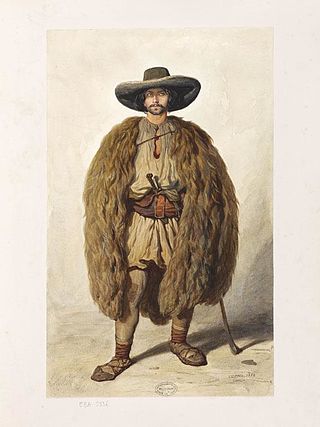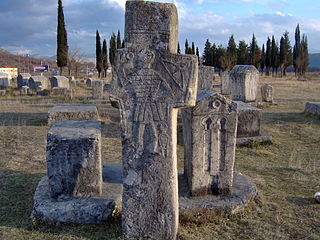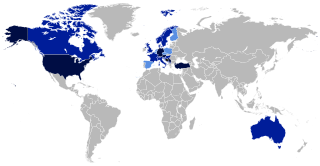Vlach is a primarily a historical exonym used to refer to some groups of speakers of Eastern Romance languages in Southeastern Europe.
Vlachs or Vlach may also refer to:

Bosnia and Herzegovina, sometimes referred to simply as Bosnia, is a country in Southeast Europe on the Balkan Peninsula. It has had permanent settlement since the Neolithic Age. By the early historical period it was inhabited by Illyrians and Celts. Christianity arrived in the 1st century, and by the 4th century the area became part of the Western Roman Empire. Germanic tribes invaded soon after, followed by Slavs in the 6th century.

Vlach, also Wallachian, is a historical term and exonym used from the Middle Ages until the Modern Era to designate speakers of Eastern Romance languages living in the Balkans and north of the Danube.

The Aromanians are an ethnic group native to the southern Balkans who speak Aromanian, an Eastern Romance language. They traditionally live in central and southern Albania, south-western Bulgaria, northern and central Greece and North Macedonia, and can currently be found in central and southern Albania, south-western Bulgaria, south-western and eastern North Macedonia, northern and central Greece, southern Serbia and south-eastern Romania. An Aromanian diaspora living outside these places also exists. The Aromanians are known by several other names, such as "Vlachs" or "Macedo-Romanians".
Bosnian may refer to:
Kovač, meaning "blacksmith" in South Slavic languages, is a common surname in Croatia, Bosnia-Herzegovina, Slovenia and Serbia.

This article is about the Demographic history of Bosnia and Herzegovina, and deals with the country's documented demographics over time. For an overview of the various ethnic groups and their historical development, see Ethnic groups in Bosnia and Herzegovina.
Bosniaks are a South Slavic ethnic group, native to Bosnia and Herzegovina and the region of Sandžak. The term Bosniaks was re-instated in 1993 after decades of suppression in the Socialist Federal Republic of Yugoslavia. The Bosniak Assembly adopted the ethnonym to replace "Bosnian Muslims." Scholars believe that the move was partly motivated by a desire to distinguish the Bosniaks from the fabricated and imposed term Muslim to describe their nationality in the former Yugoslavia. These scholars contend that the Bosniaks are distinguishable from comparable groups due to a collective identity based on a shared environment, cultural practices and experiences.
Bosnians, citizens of Bosnia and Herzegovina or people who identify as Bosnians on an interethnic basis.
Bosniak – Bošnjak, may refer to:

Stećak or Stećci in plural form is the name for monumental medieval tombstones, that lie scattered across Bosnia and Herzegovina, and the border parts of Croatia, Montenegro and Serbia. An estimated 60,000 are found within the borders of modern Bosnia and Herzegovina and the rest of 10,000 are found in what are today Croatia (4,400), Montenegro (3,500), and Serbia (2,100), at more than 3,300 odd sites with over 90% in poor condition.

The Bosniaks are a South Slavic ethnic group native to the Southeast European historical region of Bosnia, which is today part of Bosnia and Herzegovina, who share a common Bosnian ancestry, culture, history and language. They primarily live in Bosnia, Serbia, Montenegro, Croatia, Kosovo as well as in Austria, Germany, Turkey and Sweden. They also constitute a significant diaspora with several communities across Europe, the Americas and Oceania.
Vidaković is a South Slavic surname derived from Vidak and Vida family names. It is associated with Serbs, Croats, Bunjevci and Montenegrins ethnic groups and is commonly found in present-day Bosnia and Herzegovina, Croatia and Serbia.

Herzegovina is the southern and smaller of two main geographical regions of Bosnia and Herzegovina, the other being Bosnia. It has never had strictly defined geographical, cultural or historical borders, nor has it ever been defined as an administrative whole in the geopolitical and economic subdivision of Bosnia and Herzegovina.
Names of the Serbs and Serbia are terms and other designations referring to general terminology and nomenclature on the Serbs and Serbia. Throughout history, various endonyms and exonyms have been used in reference to ethnic Serbs and their lands. Basic terms, used in Serbian language, were introduced via classical languages into other languages, including English. The process of interlingual transmission began during the early medieval period, and continued up to the modern times, being finalized in major international languages at the beginning of the 20th century.
Bosnians are people identified with the country of Bosnia and Herzegovina or with the region of Bosnia. As a common demonym, the term Bosnians refers to all inhabitants/citizens of the country, regardless of any ethnic, cultural or religious affiliation. It can also be used as a designation for anyone who is descended from the region of Bosnia. Also, a Bosnian can be anyone who holds citizenship of the state of Bosnia and Herzegovina and thus is largely synonymous with the all-encompassing national demonym Bosnians and Herzegovinians.
Wallachia is a historical and geographical region of Romania.
The term Vlachs was initially used in medieval Croatian and Venetian history for a Romance-speaking pastoralist community, called "Vlachs" and "Morlachs", inhabiting the mountains and lands of the Croatian Kingdom and the Republic of Venice from the early 14th century. By the end of the 15th century they were highly assimilated with the Slavs and lost their language or were at least bilingual, while some communities managed to preserve and continue to speak their language (Istro-Romanians).
Nišić is a South Slavic surname. Its bearers are ethnic Serbs, Croats and Bosniaks.
Vlachs was a social and fiscal class in several late medieval states of Southeastern Europe, and also a distinctive social and fiscal class within the millet system of the Ottoman Empire, composed largely of Eastern Orthodox Christians who practiced nomadic and semi-nomadic pastoral lifestyle, including populations in various migratory regions, mainly composed of ethnic Vlachs, Serbs and Albanians. From the middle decades of the 17th century the amalgamation of the process of sedentarization of the Orthodox Vlachs and their gradual fusion with Serbian rural population reached a high level and was officially recognized by the Ottoman authorities.

Vlachs in Bosnia and Herzegovina are a Balkan population who descend from Romanized Illyrians (Illyro-Romans), Thracians (Thraco-Romans) and other pre-Slavic Romance-speaking peoples and the South Slavs. They practiced transhumance as herdsmen, shepherds, farmers, and in time developed peculiar socio-political organizational units known as katuns. They traded livestock products. Vlach cheese was reputable because of its fat content and fetched high prices. With their caravans, Vlach carried out much of the traffic between inland and coastal cities such as Dubrovnik. Marko Vego argued that Vlach autochthony with Vlach settlements named after Vlach tribes, Vojnići and Hardomilje, are found near Roman forts and monuments. Bogumil Hrabak supported Vego's assertion that the Vlachs preceded both Turks and Bosnian Slavs in Zachlumia. Dominik Mandić argued that some Vlachs from Herzegovina migrated there from Thessaly, Epirus and Macedonia before the Ottoman invasion into Southern Europe. It is argued that some also arrived from the East during the Ottoman wars.